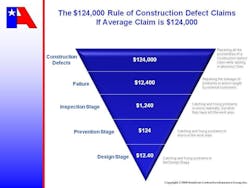Whether you like checklists or not, there’s no denying the impact they can have on ensuring things get done right the first time, every time.
In a recently published book, “The Checklist Manifesto,” this impact was shown for the healthcare industry. For example, roughly 100,000 people in the U.S. die each year in surgery due to a “complication.” Driven by this unfortunate statistic, a researcher from John Hopkins developed a short checklist that was implemented in ICUs throughout Michigan.
The results were amazing: The checklist reduced infections by two-thirds, saving 1,500 lives, and 80 percent of hospital staff said they wanted to continue to use the checklist. The remaining 20 percent were asked, “If you had an operation, would you want the checklist to be used?” Ninety-three percent said “yes.”
Checklists also have great value for the home building, remodeling, and trade contracting industries. They form the basis for data collection, such as construction defects, and allow companies to audit and evaluate how their processes function.
The chart above shows the cost difference of catching a mistake early on — during the design stage, for instance — compared to having it become a full-blown construction defect that needs repair and may result in legal action. If a checklist could help avoid these dramatic costs, isn’t it worth the effort?
When formulating checklists, make sure to involve the people who will be using them to get complete buy-in. For instance, have your trade partners participate in the creation and testing of checklists.
Also, don’t forget to use the data and communicate the findings with all key stakeholders on a regular basis. Not doing so will almost guarantee users will either lose interest in the process or simply check all the right boxes just to get the work done.
Use the data to identify issues that are recurring in your processes and then address those issues by finding and eliminating the root cause.
Finally, track how much time and money are saved by using the checklist. For example, are there less return visits to job sites? Tracking and communicating the bottom-line impacts will create buy-in and lead to success with checklists.
UP NEXT
The True Value of the NHQA Feedback Report
About the Author

Denis Leonard
Denis Leonard has a degree in construction engineering an M.B.A. and a Ph.D. in quality management. Denis is a Fellow of the American Society for Quality, a Certified Quality Manager, Auditor and Six Sigma Black Belt. He has been an Examiner for the Baldrige National Quality Award Board of Examiners a Judge on the International Team Excellence Competition and a Lead Judge on the National Housing Quality Award. A former Professor of Quality at the University of Wisconsin, he has experience as a quality manager in the homebuilding industry as well as construction engineer, site manager and in training, auditing and consulting with expertise in strategic and operational quality improvement initiatives. His work has achieved national quality, environmental and safety management awards for clients.
Denis is co-author of 'The Executive Guide to Understanding and Implementing the Baldrige Criteria: Improve Revenue and Create Organizational Excellence'.
http://www.BusinessExcellenceConsulting.net
Full listing of blogs https://www.probuilder.com/author/denis-leonard
